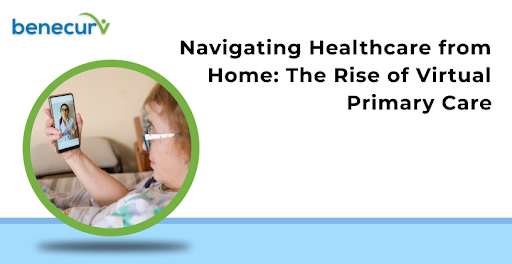
Navigating Healthcare from Home: The Rise of Virtual Primary Care
In the digital age, where convenience and accessibility are paramount, the healthcare industry is no exception to the transformative power of technology. Virtual primary care, a relatively recent addition to the healthcare landscape, has rapidly gained prominence, changing the way we access and receive employee assistance programs or other healthcare services. This blog explores the emergence of virtual primary care, its benefits, challenges, and its profound impact on the healthcare sector.
The Evolution of Virtual Primary Care
Traditionally, primary care has been synonymous with in-person visits to a doctor’s office. Patients scheduled appointments, made physical trips to healthcare facilities, and waited to be seen. However, advancements in technology and changing patient preferences have ushered in the Era of Virtual Primary Care.
Virtual primary care leverages telemedicine and digital communication tools to connect patients with healthcare providers remotely. Patients can now access a wide range of medical services, including routine check-ups, diagnosis and treatment of common illnesses, medication management, and preventive care, all from the comfort of their homes.
Benefits of Virtual Primary Care
Unparalleled Convenience: Perhaps the most significant advantage of virtual primary care is its unparalleled convenience. Patients can schedule appointments and consult with healthcare providers at times that suit their schedules, eliminating the need for time-consuming travel and reducing wait times.
Enhanced Accessibility: Virtual primary care breaks down geographical barriers. Patients in rural or underserved areas can access quality healthcare without traveling long distances, leveling the playing field for healthcare access.
Cost-Effective: Telemedicine is often more cost-effective for both patients and Healthcare providers. It reduces overhead costs associated with maintaining physical clinics, leading to potential cost savings.
Continuity of Care: Virtual primary care promotes continuity of care, as patients can easily follow up with their chosen healthcare provider. This facilitates the development of stronger patient-provider relationships and a more personalized approach to healthcare.
Reduced Waiting Times: Virtual care minimizes waiting times. Patients can typically connect with a healthcare professional promptly, reducing frustration and anxiety associated with long waiting room times.
Enhanced Preventive Care: Virtual care facilitates better monitoring of chronic conditions and promotes preventive care, leading to improved health outcomes and reduced healthcare costs.
Challenges and Concerns
While virtual primary care offers numerous advantages, it is not without its challenges and concerns:
Limited Physical Examinations: Virtual consultations may not always provide the same level of physical examination as in-person visits, which can be a limitation in some medical cases.
Technology Barriers: Not all patients have access to the necessary technology and internet connectivity for virtual care, potentially exacerbating healthcare disparities.
Data Security: Privacy and data security concerns are paramount in telemedicine. Ensuring the protection of patient information is an ongoing challenge.
Licensing and Regulation: Healthcare is heavily regulated, and the rules around telemedicine vary by region. Healthcare providers must navigate complex legal and regulatory landscapes.
Diagnostic Accuracy: Some medical conditions may require sophisticated diagnostic tools that are not readily available in virtual settings, posing challenges to accurate diagnosis and treatment.
The Impact on the Healthcare Industry
The rise of virtual primary care is reshaping the healthcare industry in several significant ways:
Shift in Patient Expectations: Patients now expect more convenient and accessible healthcare options. Traditional healthcare providers are adapting by incorporating telemedicine into their services to meet these expectations.
Increased Competition: The rise of virtual care providers is creating competition that drives innovation and leads to improved patient care experiences.
Reduced Healthcare Costs: The cost-effective nature of virtual care has the potential to reduce overall healthcare costs, a pressing concern in many countries.
Improved Population Health: Virtual care facilitates better population health management through early interventions and preventive care, ultimately improving public health.
Relief for Overburdened Systems: Virtual care can help alleviate the strain on overburdened healthcare systems, particularly during crises such as the COVID-19 pandemic, by reducing the burden on physical facilities.
The Future of Virtual Primary Care
The future of virtual primary care holds immense promise. As technology continues to advance, we can expect even more innovative solutions to emerge:
Expanded Services: Virtual primary care may expand to cover more specialized services, including mental health support, chronic disease management, and specialist consultations.
Integration with Health Records: Integration with electronic health records (EHRs) will enhance the continuity of care, allowing healthcare providers to access patient histories and deliver more informed care.
Artificial Intelligencerae (AI) Integration: AI-powered tools can assist healthcare providers in diagnosis and treatment recommendations, improving accuracy and efficiency.
Remote Monitoring: Wearable devices and remote monitoring technology will play a larger role in virtual care, enabling real-time tracking of patient health.
Telehealth Policies: Governments and healthcare regulatory bodies will likely continue to develop and refine telehealth policies to ensure patient safety, data security, and quality of care.
Conclusion
The rise of virtual care represents a transformative shift in how healthcare is delivered and experienced. These employee assistance programs offer unparalleled convenience, accessibility, and cost savings, making healthcare more patient-centered. While challenges exist, ongoing technological advancements and evolving healthcare policies are likely to address many of these issues.
Virtual primary care is not just a trend; it’s the future of healthcare. Patients, providers, and healthcare systems should embrace this evolution and work together to ensure it benefits everyone. The future of healthcare is happening from the comfort of our homes, and it promises a healthier, more accessible, and more patient-centric approach to medicine.
Featured Topics

My Benefits

Dental

Disability Insurance

Life&AD&D

Medical

Benefits Guide
